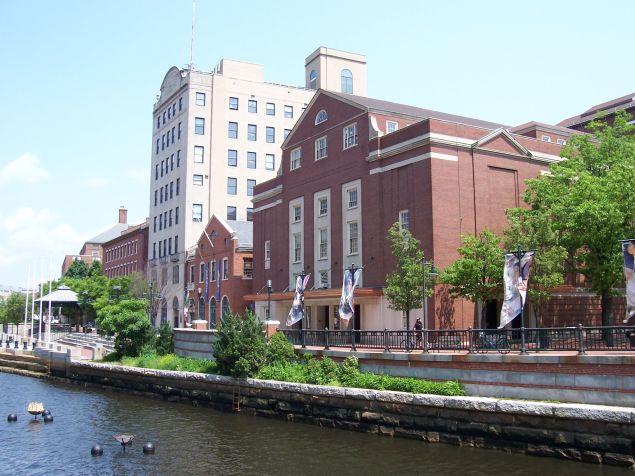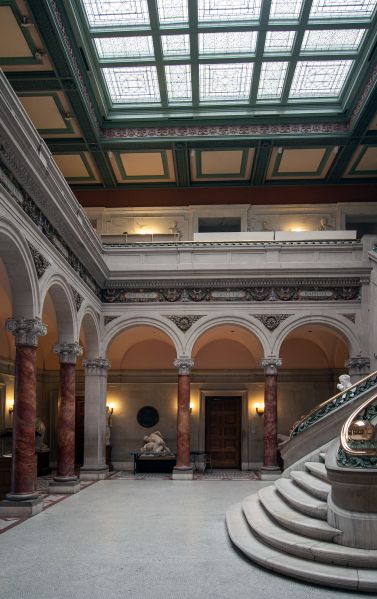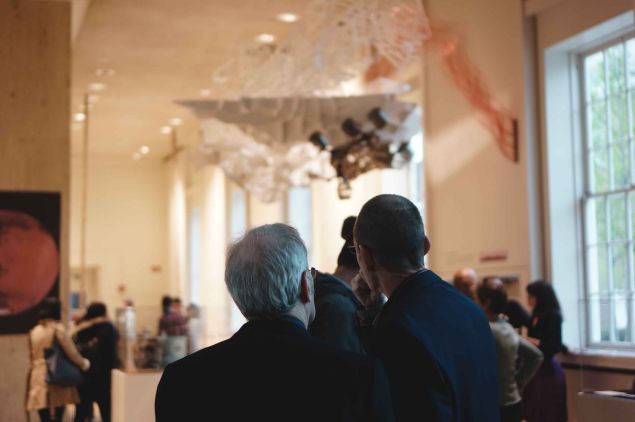
Colleges and universities have become touchy places of late, with their “safe spaces,” “trigger warnings” and denunciations of “microaggression.” Comedians Jerry Seinfeld and Chris Rock announced that they have sworn off doing shows on college campuses because of so often being accused of racism, sexism and more. Yet, colleges and universities are where almost every professional visual artist receives his or her training, which has the potential to make balancing free expression and the concern for group sensitivities an arduous and ongoing task for faculty and administrators. Unlike Jerry Seinfeld and his jokes, college art instructors cannot just take their lesson plans to some local concert hall. In an environment set up to encourage experimentation and free expression, is parody or a critical stance allowable and, if so, which targets are O.K.?
“Art school is a safe space for testing boundaries,” said David Bogen, provost at the Maryland Institute College of Art in Baltimore, but one person’s safe space may collide with another’s. Certainly, physical safety is a real concern at the independent art college, and in the school’s student and faculty handbook there are pages devoted to limiting certain types of art speech: Animals must be treated “in a humane manner when used in/as art work,” no setting off fireworks, displaying or using weapons, possession or use of illegal drugs or alcohol, no exposing others to “blood, urine, feces, chemicals or other hazardous materials.” Students are reminded that graffiti art on public property is “vandalism,” and they should lay off the nearby Corpus Christi Church on whose door one student’s art project was to attach a commentary on sexual abuse by priests.
Avant-garde art these days pointedly looks to speak truth to power, identifying a response to that power in a variety of evermore provocative ways. The pros do it, why not students? At the University of Kansas some years ago, a female student in a performance art class “cut her breast and bled,” said her professor at the time, Roger Shimomura, who happened to know that the student had AIDS. The reason for her cutting herself was “nonspecific, political or feminist, I don’t know.” He considered stopping the performance “for safety sake” but did not because that “would reveal to her classmates her medical situation.” At Vanderbilt University, one of professor Michael Aurbach’s assignments to students in his kinetic art class was to create a machine that would make a sound or keep moving or make marks on a piece of paper for at least 30 seconds. One female student created a machine with a pulley system that withdrew a tampon from her body (she was wearing no underwear) and then made marks on paper with the wet end. Again, political or feminist, I don’t know.
Provocation may result in someone actually taking offense, and all school administrators and faculty may be able to do with a clear conscience is to limit the damage to the educational institution itself. In a 3-D design course at relatively conservative Oklahoma State University, a female student dragged a 10-foot-long wooden crucifix into class as an Easter-themed project. “All the faculty and administrators were running around wondering what to do,” said sculpture professor Sallie McCorkle. “I mean, this is a pretty conservative, Christian area. Some faculty wanted to get rid of it—you know, censorship—but I said that it was O.K. with me as long as it didn’t block any egress.” That decision didn’t cause a fuss, but McCorkle knows what a fuss is. Back in the late 1990s, when she was associate professor of visual arts and women’s studies at Penn State University, one of her students exhibited a sculpture of Virgin Mary emerging from a cave that closely resembled a vagina. Protests came from within and outside the school (some state legislators threatened to cut off all funding), and the student decided to remove the work after five days on display. McCorkle, who publicly defended, on free speech grounds, the student who created the sculpture, received death threats and “had to call the police several times to clear out protesters from my classroom.”
From time to time, edgy student artwork leads to positive outcomes if it gets people at the school and elsewhere to talk about important issues. In September 2015, Ashley Powell, an African-American student in the master of fine arts program at the State University of New York at Buffalo posted “White Only” and “Black Only” signs next to
At other times, conversations may be less productive. In 1999, a poster created by a design student at the Rhode Island School of Design for the annual senior show included an image of the actress Esther Rolle from the 1970s television show Good Times. Downloaded off the internet, the picture showed her smiling and at work at an ironing board; the student created a balloon caption above her head with the words “Come to the show.” The poster was removed by school administrators after black students there protested. The administration, which had been increasingly sensitive to issues of diversity, denounced the poster as racist and required that the entire senior class attend a mandatory conference on issues of race. Ned Dwyer, then associate provost and dean of students at RISD and now a professor of art and architecture there, stated at the time that “we came to the conclusion that, in this day and age, race is a greater problem than freedom of speech.”
Freedom of expression is difficult, as one person’s freedom may seem like oppression to someone else. In 2015, the same Princeton University students, calling themselves the Black Justice League, who demanded the institution change the name of the Woodrow Wilson School of Public & International Affairs because of instances of racism on the part of the 28th U.S. president (Princeton refused), also demanded a “public conversation, which will be student led and administration supported, on the true role of freedom of speech and freedom of intellectual thought in a way that does not reinforce anti-blackness and xenophobia.” The year before, at St. Louis University, two community groups—Tribe-X and the Metro St. Louis Coalition for Inclusion and Equity—made a number of demands on the institution that included it paying pay for a “mutually agreed upon commissioned artwork” that speaks to the issues of racial profiling and police abuse. The university agreed to do so and presumably will find some artist who can create to these specifications.
Balancing the importance of free expression with religious, racial and social sensitivities is an ongoing effort at art colleges and university art departments, probably a more precarious job of juggling at state-funded institutions than at private colleges. Private schools are answerable only to their trustees and immediate community, whereas public institutions additionally may be condemned by citizens’ groups and legislators for spending taxpayer money on blasphemy, homoeroticism, pornography, racism or something else to which they object. Art faculty and administrators at public institutions may have to be sensitive not only to minority groups within their communities but to the political winds. “We definitely have more freedom here,” said Kent Devereaux, president of the New Hampshire Institute of Art in Manchester, “than at state universities, which are under a more watchful eye by legislators and the media.” Sallie McCorkle said “thank God I had tenure” when she took on the National Catholic League, nervous university administrators and state legislators over that Virgin Mary artwork during her time at Penn State, “but I knew that, if I didn’t succeed, life would get much worse for me there.” Even at Vanderbilt University, a private institution, Michael Aurbach was worried about the consequences of publicly exhibiting that tampon-extracting machine, eventually deciding to seclude the artwork in a separate room with a sign above the door warning that the content might be offensive to some. “I told the student, ‘I don’t want to censor you, but I also don’t want to lose my job.’ ”
The balancing act tips this way and that. A former president of the Memphis College of Art in Tennessee “wanted free expression to be unhindered,” said Susan Miller, vice president of student affairs, adding that the current view takes into account sensitivities of the various people who may look at the artwork. “The college allows itself the right to say, ‘No, we won’t hang this,’ but if we do allow an artwork to be hung, we won’t take it down.” This policy was tested recently when a student created a painting of Elvis Presley on black velvet with the singer’s face crumbling and ants walking across the portrait that was exhibited during the month-long Elvis celebration in the city. “Elvis fans were very unhappy and complained to the college, asking the college to remove the piece. The college would not comply.” However, warning signs may be put up around controversial art pieces, and “the college reserves the right in certain situations to post a warning sign or temporarily cover or remove works that may be judged by representatives of the college inappropriate for some members of the MCA community or its guests,” according to the student handbook.
At every art college and university art department, the principal response to potentially controversial artwork that a student wishes to exhibit is a talking-to. “We sit down with the student and have a very, very, very long talk about what they’re doing and make sure they are aware of the territory they are getting into,” McCorkle said. Ultimately, however, the decision to create potentially offensive artwork is the student’s. “What is my responsibility as a teacher? Is it to stop a student from creating racist or misogynistic or antisemitic art or is to help the student make the artwork better, even if that means helping the student make it more racist? I think it is the latter but, again, thank God for tenure.”

Howard Singerman, who chairs Hunter College’s fine arts department and also lauded “the joys of a tenuring institution,” similarly noted that faculty—and, if needed, administrators—would discuss with art students looking to display something that is likely to offend someone “what their intentions are, what kind of dialogue the work is likely to engender, the context of the work and where their reaction is coming from.” Unlike the Maryland Institute College of Art and the Memphis College of Art, Hunter College art students are not provided with a list of prohibited activities, although incoming graduate students are told about “fireworks, lighting fires and bodily fluids” in the same introductory speech that mentions the fire code and how to dispose of hazardous art materials, he said. “Laying out interdictions and prohibitions beforehand isn’t the best way to get students to produce artworks that foster dialogue, we have found.”
The other way that art colleges and universities try to work with students whose art may be viewed as offensive by some is through offering courses that focus on the role art plays in the general society and the responsibility that artists have to the community and culture in which they live (in many other schools, the ideology of these courses is simply folded into critical theory classes). At Portland State University in Oregon, for instance, studio art students may take an ethics of engagement class that “it is built around three themes: ethics, from a philosophical and anthropological point of view, anti-oppression theory, which examines race, gender, class, national origin and similar dynamics in contemporary U.S. society, and the notion of community,” said Patricia Vazquez, who teaches the course. She noted that students are not taught what is politically correct or incorrect but are provided “critical thinking tools.” She added, “Of course I have my own value system that the class is infused with, and that defines what critical lenses I am offering.”
Every manner of addressing potentially offensive art displays has its benefits and drawbacks. Private conversations or artist-as-citizen classes create opportunities for competing ideas to be expressed, which is the role of the college or university, but it also may have a chilling effect. A student’s sit-down with one’s professor or department chairman is not a meeting of equals, and students may well believe that pursuing their original intentions could affect their grades and future prospects. An entire course on ethics could be a lesson in group think or intellectual bullying, magnifying the alienation a student feels. Placing warning signs before artwork may limit the number of people who will see it and certainly removes the surprise element that the creator of the artwork is counting on.
Not every art instructor can be so even-handed with artwork they find offensive. Gregory Sholette, associate professor of sculpture and social practice at Queens College, part of the City University of New York system, stated that “there are definitely areas of expression, representation or enactment I would refuse to allow in my classroom under most circumstances, and these include actual or depicted violence against another person or living animal or presentation of an explicitly racist, homophobic, sexist, ageist or otherwise insensitive image, speech or action/performance.” Still, he noted that it isn’t always clear what constitutes inappropriate speech or outright hate speech and that “the exact intent of the work” should be evaluated as part of a class critique. However, “if there seemed to be real hostility involved, it could require calling in a counselor to privately discuss matters with the student if the situation warranted that.”
However, that is all largely theoretical, as none of Sholette’s students have ever created explicitly racist, homophobic, sexist or ageist art projects. This view was seconded by William McClure, dean of faculty in the division of arts and humanities at Queens College, who said that the campus “prides itself on cultural diversity and sensitivity to others.” In his 19 years working there, no highly contentious artwork have been put on display. Perhaps that is a problem. “The issue for our students might be to get them to break out of the box.”














You must be logged in to post a comment Login